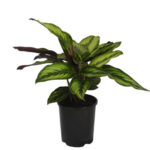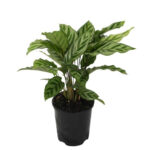Description
Fertilize it every three weeks in its growing month of summers with rich nitrogen content fertilizer. In winters, feed the fertilizer less frequently, but avoid overfertilization to prevent damage to the foliage.
Report Calathea annually in rich well-draining soil in a one-size larger pot when it outgrows its current pot.
Calatheas can be propagated by division of the main rhizome after the parent plant has grown enough in size and is mature. It can also be propagated by stem cuttings.
Calatheas are known to be temperamental. But, with the right amount of water and sunlight they can be grown indoors very easily. Keep it near a window or in your shaded balcony where it receives sufficient indirect light.
Plants growing in containers need more fertilizing than those in the ground. The more you water, the more quickly you flush the nutrients out of the soil.
Some of the problems faced by these plants are
Under-watering and excessive use of fertilizer both can lead to the browning of leaves. Water the plant less frequently and reduce the amount of fertilizer usage if this problem occurs and persists.
The curling of Calathea’s leaves is caused due to lack of moisture. Make sure to water the plant adequately to avoid this. Also, mist Calathea several times a week.
Yellowing leaves are a sign of over-watering. If there are yellow leaves, check the soil and roots. If the roots are too mushy, reduce the frequency of watering to avoid root rot.
Difficulty: Hard
Light: Bright indirect sunlight
Watering: Water once a week
Place: Bright indoors, shaded outdoors
Character: Air-purifying


































Sunil Ghorpade (verified owner) –